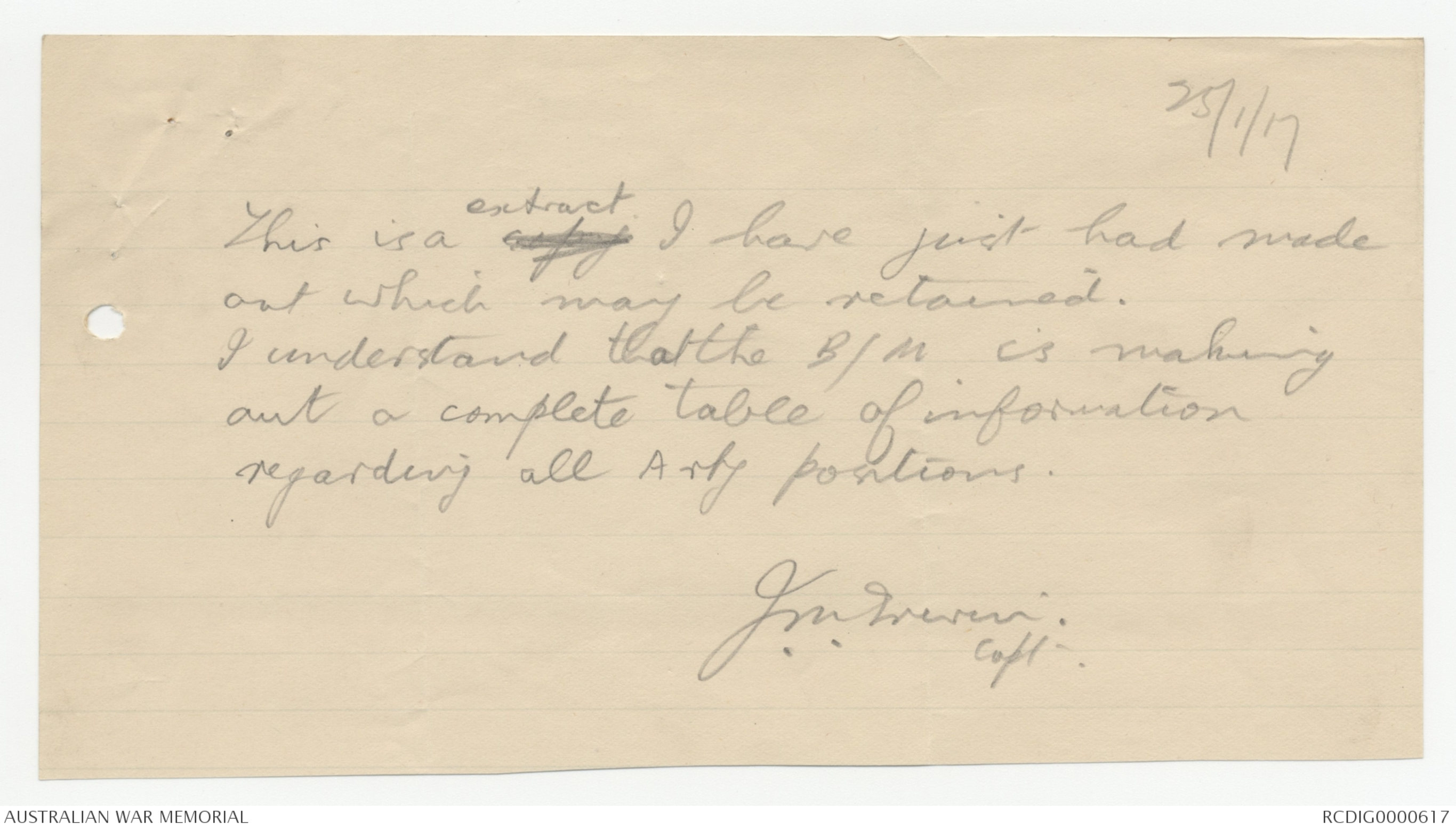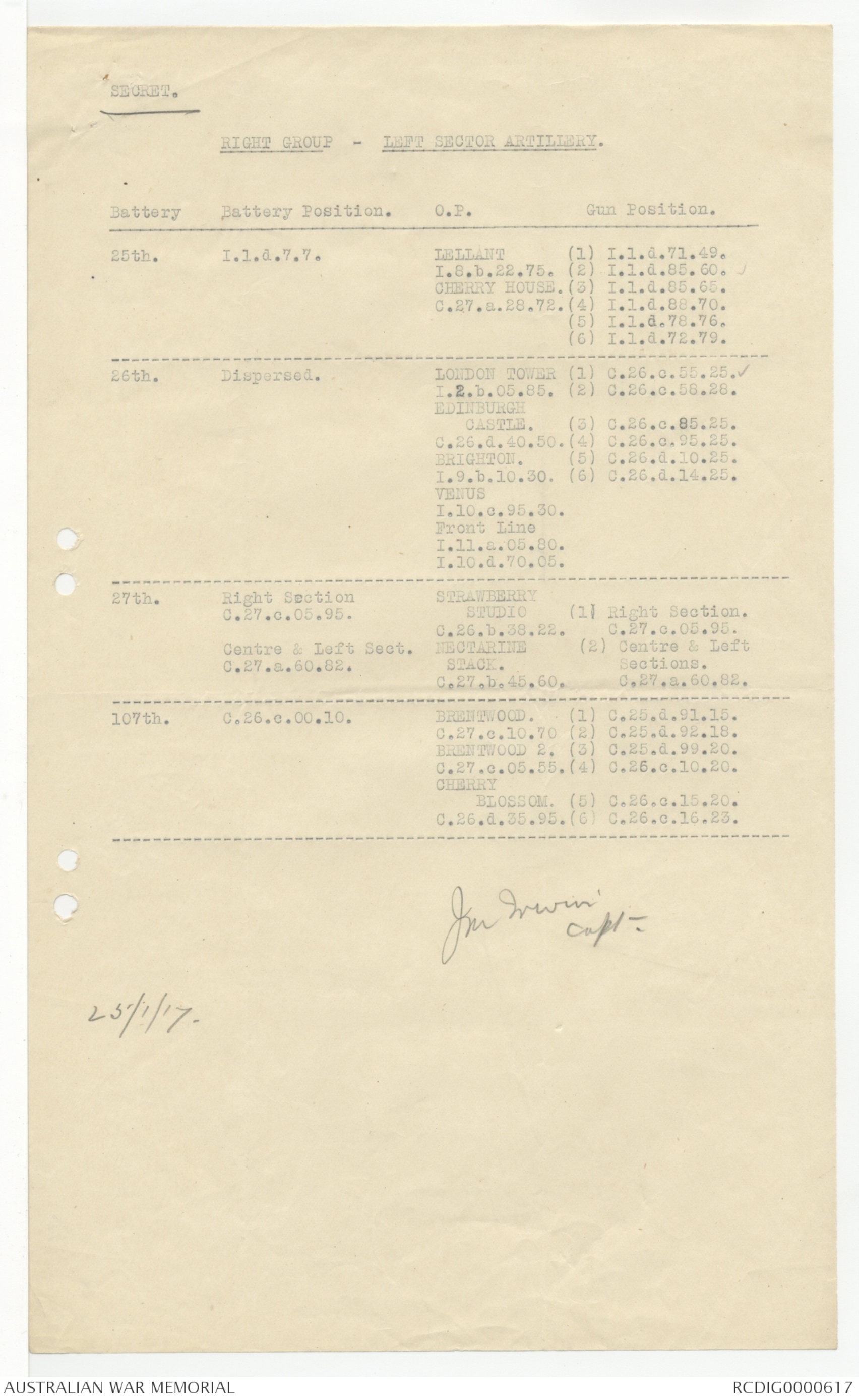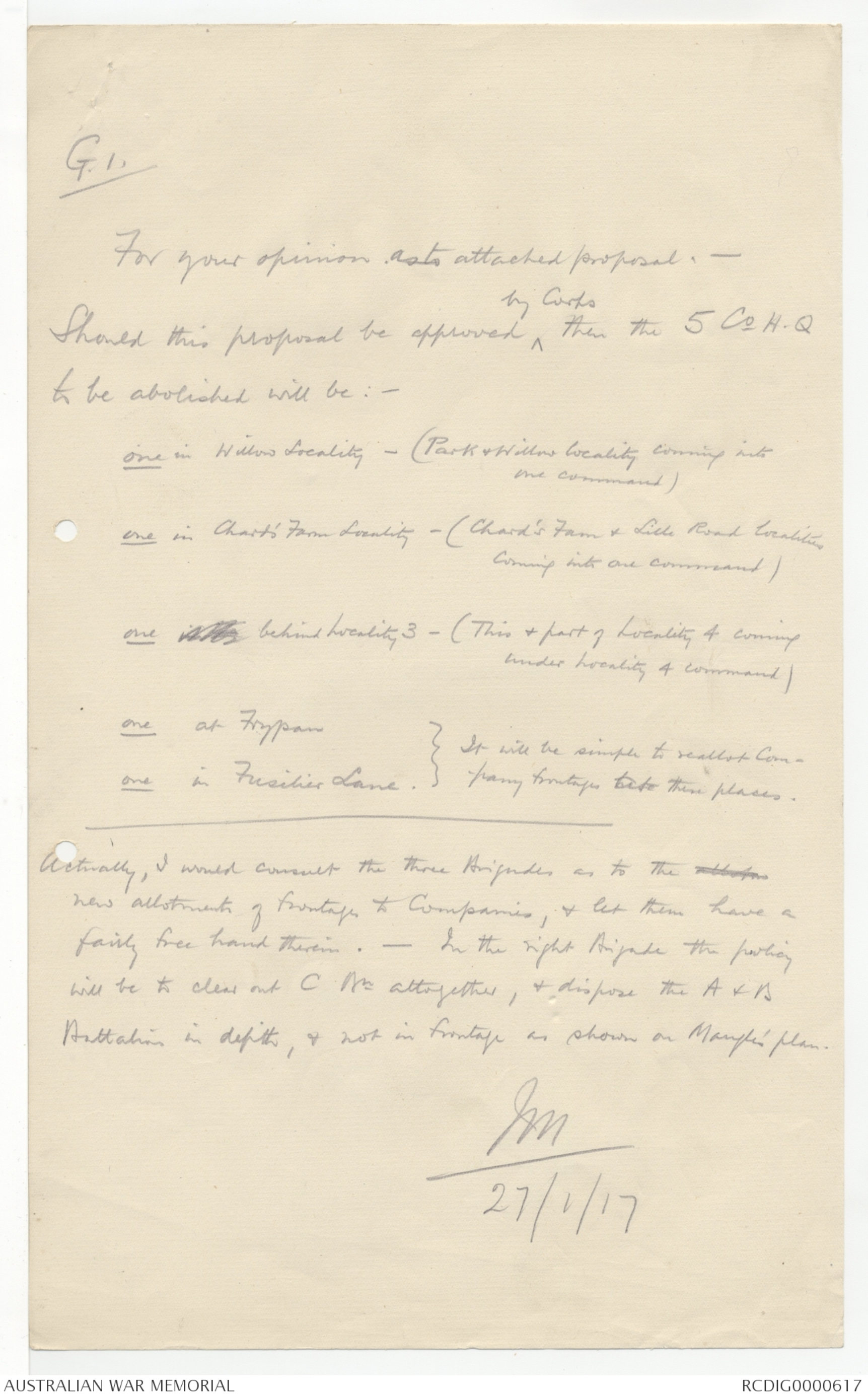Sir John Monash, Personal Files Book 14, 1 December 1916 - 10 February 1917, Part 12










7/
ARTILLERY cont'd (16) rear of and to the flanks of positions to be
attacked.
Phase 2. ZERO plus FIVE MINUTES to ZERO plus EIGHT MINUTES
Barrage lifts off portion of the
front line to be attacked & engages second
objective.
Phase 3. ZERO plus EIGHT MINUTES to ZERO plus TEN MINUTES
Artillery engages third objective.
Phase 4 ZERO plus TEN MINUTES till "ALL CLEAR"
Barrage lifts from the third
objective & engages communications
in rear & trenches on flanks.
Phase 5 "ALL CLEAR" till "CEASE FIRE" or ZERO HOUR
plus ONE HOUR
As in Phase 1.
An Artillery LIAISON Officer will be
with O.C. RAID.
REPORTS (17) Reports to Brigade Headquarters
(LEFT BRIGADE) by wire during raid, to
be followed by reports in writing; complete
report to be submitted at conclusion of
raid.
SPECIAL (18) Copies of this order will on no account
be taken beyond Battalion Headquarters. All
copies to be returned to this office by 12
Noon on the day following "Z" day.
ACKNOWLEDGE
WE Smith
Major
Brigade Major
10th Aus. Infantry Brigade
8/
DISTRIBUTION
Copy No 1 Filed
2 War Diary
3}
4} 3rd Aus Div by DR at 12.45 pm 23-1-17
5}
6 GOC
7 B.M.
8 Capt J A Lambden " " " "
9 37th Battn - " " " "
10 38 " " " " "
11 39 " " " " "
12 40 " " " " "
13 10th MG Coy " " " "
14 10 TM Btty " " " "
15 8th Bde A.F.A. " " " "
16 11th Aus Inf Bde " " " "
17 9" " " " " " " "
18 75" Inf Bde " " " "
19 C.R.A. delivered by GOC.
20 10th F Coy Engrs By DR at 12.45pm 23-1-17
21 OC L. Coy R.E. " " " " "
22 10th Bde Div Sigs " " " " "
23 Div Sig Coy " " " " "
24 C.R.E. " " " " "
25 10th F. Ambulance " " " " "
25/1/17
This is a copy extract I have just had made
out which may be retained.
I understand that the B/M is making
out a complete table of information
regarding all Arty positions.
J.M. Irwin
Capt.
| FRANK'S FORCE. | RELIEVED BY. | POSITION. | WAGON LINES. |
| B/175 | 25th. Battery 7th.F.ABdge. | I.1.d.85.60 | H.1.b.5.5. |
| A/152 | 26th " " | B.26.d.4.4. | |
| A/175 | 27th. " " |
C.27.c. 65.90. |
B.26.d.4.4. |
| D/175 | 107th. " " | C.26.c.00.10 | H.1.b.5.5. |
| 2nd.Battery | 29th. " 8th. F.A. Bgde. | I.2.a.45.95. C.20.b.70.25. |
B.27.d.1.8. |
| 9th. " | 30th " " | C.25.b.45.65..... C.26.a.10.50. |
B.28.d.6.8. |
| 5th. " | 31st. " " | C.27.a.10.85. | B.21.a.2.2. |
| 6th. " | 108th. " " | C.26.b.90.60. | B.14.c.8.2. |
L J Nicholls
Major R.A.
25/1/17
SECRET.
RIGHT GROUP - LEFT SECTOR ARTILLERY.
| Battery | Battery Position | O.P. | Gun Position |
| 25th | I.1.d.7.7. | LELLANT | (1) I.1.d.71.49. |
| I.8.b.22.75. | (2) I.1.d.85.60 | ||
| CHERRY HOUSE | (3) I.1.d.85.65 | ||
| C.27.a.28.72. | (4) I.1.d.88.70 | ||
| (5) I.1.d.78.76 | |||
| I.1.d.72.79 | |||
| 26th. | Dispersed | LONDON TOWER | (1) C.26.c.55.25 |
| I.2.b.05.85. | (2) C.26.c.58.28 | ||
| EDINBURGH CASTLE | (3) C.26.c.85.25 | ||
| C.26.d.40.50 | (4) C.26.c.95.25 | ||
| BRIGHTON | (5) C.26.d.10.25 | ||
| I.9.b.10.30. | (6) C.26.d.14.25 | ||
| VENUS | |||
| I.10.c.95.30. | |||
| Front Line | |||
| I.11.a.05.80. | |||
| I.10.d.70.05 | |||
| 27th. | Right Section | STRAWBERRY STUDIO | (1) Right Section |
| C.27.c.05.95 | C.26.b.38.22 | C.27.c.05.95 | |
| Centre & Left Sect. | NECTARINE STACK | (2) Centre & Left Sections | |
| C.27.a.60.82 | C.27.b.45.60 | C.27.a.60.82 | |
| 107th. | C.26.c.00.10 | BRENTWOOD. | (1) C.25.d.91.15 |
| C.27.c.10.70 | (2) C.25.d.92.18 | ||
| BRENTWOOD 2. | (3) C.25.d.99.20 | ||
| C.27.c.05.55 | (4) C.26.c.10.20 | ||
| CHERRY BLOSSOM | (5) C.26.c.15.20 | ||
| (4) C.26.d.35.95 | (6) C.26.c.16.23 |
J M Irwin
Capt
25/1/17
G.I.
For your opinion as to attached proposal. -
Should this proposal be approved ^by Corps then the 5 Co H.Q.
to be abolished will be: -
one in Willow Locality - (Park & Willow locality coming into
one command)
one in Chard's Farm Locality - (Chard's Farm & Lille Road localities
coming into one command)
one xxx behind Locality 3 - (This & part of Locality 4
coming under Locality 4 command)
one at Frypan - } It will be simple to reallot
} Company
one in Fusilier Lane - } frontages xxto these } places.
Actually, I would consult the three Brigades as to the xxxxxx
new allotments of frontages to Companies, & let them have a
fairly free hand therein. — In the right Brigade the policy
will be to clear out. C Bn altogether, & dispose the A & B
Battalions in depth, & not in frontage as shown on Maugher's plan
JM
27/1/17
Koninginnency 58.
Amsterdam, 26.1.17
My Dear uncle Ethan,
The books of the late
Chief Rabbi Marasch from
Utrecht will be sold here
by auction on Febr. 12th &
I told the auctioneer
R. W. P. de Vries, Lingel 145,
to send you a catalogue.
If I can be of any use to
you, I shall be glad.
We are all very well &
hope you are the same.
Best love Yours affectly
Annae.
BRIEFKAART
Amsterdam 27.1.1917
Afzender. [[?}} Heilbut.
Koninginnency 58.
Elkan N. Adler Esq
20 Porchester Square
Bayswater
London W.
THIRD AUSTRALIAN DIVISION.
Divisional Headquarters
January 28th, 1917.-
CIRCULAR MEMORANDUM NO. 46
CASES OF SUSPECTED SHELL SHOCK.-
Any man reported to be showing signs of shell shock
will have his case investigated by his Commanding Officer at
once, from a disciplinary point of view.
The results of the investigation will be forwarded to
Headquarters Division only and not as heretofore to Second
Army.
The Regimental Medical Officer will submit his report
independently to the A.D.M.S.
The A.D.M.S. wil hold the case at the D.R.S. and
will report upon it to Divisional Headquarters.
H. FARMAR, Lieut-Colonel
A.A. & Q.M.G., 3rd. Australian Division.
from General Jobson.
29th January, 1917.
We have had our first real fight. There have of
course been Artillery duels, Trench Mortar shoots and sniping
exhibitions. But until to-day week we have not in our section
had anything like a decent stunt. It came on January 22nd,
just when we were at lunch. One of the units rang up to say
that the Hun was putting over rather more shells than usual.
Our guns had replied, but the shelling instead of lessening had
increased. New shells such as our men had never before seen
were coming over. "As big as half a man" one man described them,
meaning the heavy 9.8" Minnenwerfer shells 40 inches long -
"Coalboxes" is the common term for them. Fired from a Mortar
they come tumbling over and over. The Hun took great pains on
this particular afternoon to give us a good variety. Over
front of 1000 yards he spread his fire. Minnies, small, medium
and heavy, rifle grenades along the front line, 77 m.m Shrapnel
and H. . a little further back, and further back still 5.9 H. .
and shrapnel. For a breadth of 1000 yards and a depth of about
1500 his fire extended on to trenches, (support and communication)
This went on, with just one interval when he slackened
a little, for 3 hours. During this time we were giving him
shrapnel and H. . and some very heavy stuff from Howitzers and
big guns. He was however determined to go on, and he did. At
about ¼ to 5, after about 3 hours, men were seen leaving his
trenches headed by a man (probably an Officer) in a blue uniform.
He was promptly shot for the distance between the trenches was
not more than 250 yards, and his fire had not, strange to relate,
knocked all our men out, and there were still some handy with
rifle, Lewis and Vickers guns to shoot at him as he came. His
fire though heavy was only intense on one particular area, and
everyone in that area except two - Captain Wells and a private
named Corkhill, had been killed or wounded. Lieutenant Carmichael
had done great work and escaped injury right up to the time of
the Huns coming when just previously he was half blinded and wounded
(though not severely) by a bursting shell. He was taken off to the
rear just before they arrived, and there were only two left to
meet the Huns. On they came yelling like madmen, not in any special
formation, but in practically any old way. No proper extension,
but with intervals of bunches of men. As they came the men were on
the right flank of the trench for which they ran dropped many of
them in their tracks, Estimates of the actual. number of the raiders
vary, but there were probably about 150 of them. At last they
reached the trench which they found empty. They ran about shrieking
and gabbling and bombing empty dug-outs. Captain Wells (with
only Corkhill left) decided the best thing and only thing to do
was to defend his dug-out, and there he made his stand. The mob
(Wells described the Huns as "a drunken rabble) came along the
trench, and Corkhill who began to put up a fight was at once shot
through the chest with a revolver bullet. At Wells they threw a
bomb which knocked his revolver out of his hand while a second blew
him flat into his dug-out. Strange to say the Bosches did not press
their advantage and enter it, but passed on leaving Wells to come
to his senses unmolested. They passed on further down to the left
and there probably to their great surprise came upon some men who
by keeping well to the left had escaped the barrage. The barrage
had of course been lifted off the front trenches to let the Huns
in, but elsewhere shelling was going on as hard as ever. Our men
were probably a bit surprised too, for the arrival of the Huns
could not be seen from where they were. However one private promptly
shot the leading Bosche in the act of throwing a bomb. The
bomb exploded and completed the job and the Hun was a corpse. The
others got into a panic and turned and fled over the parapet. They
had brought with them two demolition charges, but failed to use
them. One they did not attempt to use and it was found intact.
The other placed in a dug-out was found to have misfired. As they
ran the men on either flank manned the parapet, some even got on
top of it and shot at the fleeing Huns. It was now getting dark,
 Maralyn K
Maralyn KThis transcription item is now locked to you for editing. To release the lock either Save your changes or Cancel.
This lock will be automatically released after 60 minutes of inactivity.